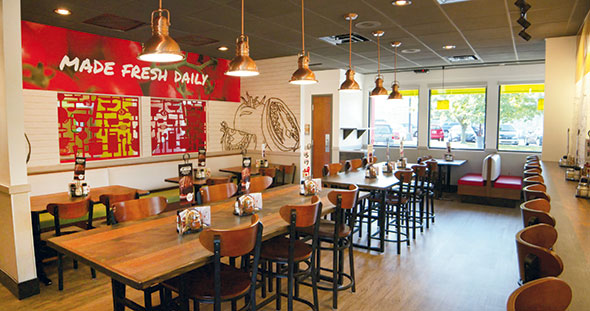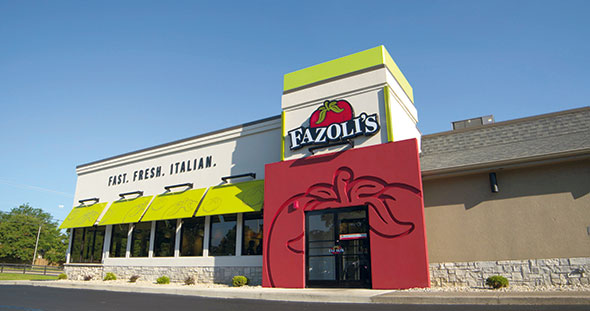A decade ago Fazoli’s was a flailing brand with numerous store closings and declining sales. The Italian concept, says CEO Carl Howard, was “positioned in the QSR space. We were getting killed. I came in and did a brand study to find out why the brand was performing so poorly. We really got no credit for food quality or for service, and that’s pretty much what we do for a living.”
 Fazoli’s new interior offers guests multiple seating options, making for an unusually comfortable environment in the QSR space.That study led to a major rebrand of the chain — one that ultimately resulted in a category shift. Instead of being a straight quick-service operation, Fazoli’s now views itself as an “elevated QSR,” similar to concepts like Culver’s and Whataburger. At around $7.50 a meal, Fazoli’s prices are slightly lower than many fast-casual operations, says Howard, who adds that he believes the quality and service Fazoli’s offers also rank above traditional fast food.
Fazoli’s new interior offers guests multiple seating options, making for an unusually comfortable environment in the QSR space.That study led to a major rebrand of the chain — one that ultimately resulted in a category shift. Instead of being a straight quick-service operation, Fazoli’s now views itself as an “elevated QSR,” similar to concepts like Culver’s and Whataburger. At around $7.50 a meal, Fazoli’s prices are slightly lower than many fast-casual operations, says Howard, who adds that he believes the quality and service Fazoli’s offers also rank above traditional fast food.
Finding this space between spaces has been a matter of upgrading or adjusting practically everything about the operation.
Much of this work started with the menu. Fazoli’s evaluated literally every ingredient in its kitchen and every component of every dish, making several upgrades as a result. For example, the company no longer uses any precooked chicken, tomato-based sauces now use cold-pressed tomatoes and the Alfredo sauce has more dairy.
The chain has also added new menu items, with a focus on its popular baked pasta dishes, like lasagna and baked spaghetti with meatballs. These menu changes were accompanied by tweaks to the chain’s kitchen setup. The restaurant reworked its flow to reduce steps in the back of the house and added fast-cooking ovens to speed the production of its baked pastas.
Surprisingly, though, Fazoli’s menu at first didn’t result in the improvements the chain expected, says Howard. “As we elevated the menu, we didn’t necessarily get the credit that we should have received. Sales went flat and I thought sales would bounce. We weren’t getting the food quality scores we were expecting. Really it’s because you can put great food on a Styrofoam plate and you’ll get a substandard score.”
In response, Fazoli’s did something highly unusual within the QSR space: it dropped disposables for dine-in guests in favor of real plates and real flatware.
The chain then matched this improved presentation with improved service in the front of the house. Fazoli’s ditched pagers in favor of table runners — a big help to seniors, parents with small children and large groups. Staffers also cover front-of-the-house functions such as pre-bussing tables, offering guests fresh-grated parmesan and delivering fresh, free breadsticks on request.
The interior itself has also gotten a refresh by way of a new art package with freshness cues and multiple seating options, including booth, banquette, counter-height and community tables.
This high-touch approach isn’t confined to the restaurant’s four walls, though. Drive-thrus are a big part of nearly all successful QSRs, and Fazoli’s is no different. The chain created a “drive-thru of the future” with an aesthetic that gels with its new interior, including wood-style panels, freshness cues and a larger, easier-to-read menu.
“It doesn’t necessarily drive more throughput, but it makes it easier for the consumer. It’s not as cluttered. It’s a really clean, professional look so the drive-thru guest gets a remodeled experience also,” says Howard.
Responsive Customer Service
The chain is carrying its high-touch approach into the digital space, as well. In addition to standard offerings like an app and online ordering, Fazoli’s uses a service that allows it to closely monitor its reviews across different sites, including Yelp, TripAdvisor and Google reviews. Each morning
Howard receives a rundown of all one- and two-star reviews from the day before.
 The redesigned exterior includes an enhanced tower element that has more height and better illumination.This does more than provide the company with real-time information on restaurant performance. It also gives Fazoli’s the chance to make things right with unhappy customers, Howard says. “We communicate to every one of those guests within 24 hours with an apology and some type of incentive to come back and try us again.”
The redesigned exterior includes an enhanced tower element that has more height and better illumination.This does more than provide the company with real-time information on restaurant performance. It also gives Fazoli’s the chance to make things right with unhappy customers, Howard says. “We communicate to every one of those guests within 24 hours with an apology and some type of incentive to come back and try us again.”
This sort of responsiveness is important for a chain with just 220 locations, Howard notes. While he doesn’t have the size to advertise on television like the QSR giants, in the digital realm Fazoli’s can be more responsive and innovative than those companies, he says.
All this — from the updated menu to the redesigned interior to the high-touch service — helped turn Fazoli’s fortunes around. The chain’s last 10 remodeled stores posted 12.5 percent higher sales compared to non-remodeled locations. Even better, after closing scores of units early in his tenure, Howard now sees significant growth ahead for Fazoli’s. The company opened 10 new units in 2018 and forecasts opening more than 50 restaurants in the next 3 years, including in markets it once left.
“Consumers use us because they want a better experience than burgers and fries and tacos and chicken and they use us as a value play to trade down from the Olive Garden,” says Howard. “We’ve got a nice little white space and we’re going to sneak up on people pretty quickly. We’ve got it figured out and we’re rolling now.”




